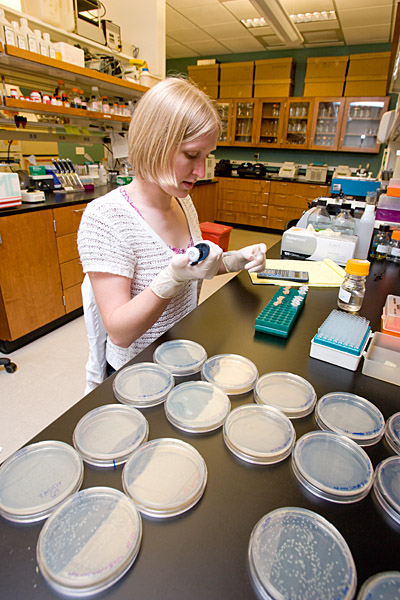UGA researchers find hormone receptor that allows mosquitoes to reproduce

Athens, Ga. – University of Georgia entomologists have unlocked one of the hormonal mechanisms that allow mosquitoes to produce eggs.
The results provide insight into how reproduction is regulated in female mosquitoes, which transmit agents that cause malaria and other diseases in humans and domestic animals. Their work was published in the April edition of the Proceedings of the National Academy of Sciences.
The model for this research is the yellow fever mosquito, Aedes aegypti. Females have to consume a blood meal before they are able to produce a batch of eggs. The blood meal triggers the mosquito’s brain to release two hormones, an insulin-like peptide known as ILP and an ovary ecdysteroid-ogenic hormone known as OEH, which activate processes in the female mosquito that result in mature eggs.
Many hormones, including OEH and ILP, act through receptors on the surface of cells. In 2008, study co-authors Mark Brown, a professor of entomology, and Michael Strand, a Regent’s Professor, characterized the receptor for ILP in mosquitoes, which helped reveal many details about its role in egg formation. OEH plays an equally important role in female reproduction, but its receptor was more difficult to identify.
“From previous work, we knew that the fruit fly Drosophila melanogaster does not produce OEH. A different group of fruit flies, including Drosophila mojavensis—as well as all mosquitoes we had genomes for—do have OEH,” said the study’s lead author Kevin Vogel, a postdoctoral fellow also in the College of Agricultural and Environmental Sciences’ entomology department.
“Most hormones bind a single receptor, so we hypothesized that an OEH receptor should be found in mosquito genomes as well as Drosophila mojavensis, but not in the genome of Drosophila melanogaster.”
By identifying and comparing the sequences of more than 400 receptors in the genomes of two fruit flies and three mosquito species, they identified a single gene for a receptor with an unknown function within the species distribution they expected.
By targeting the gene encoding the receptor, the authors found that disabling its expression inhibited the mosquitoes’ ability to produce eggs after a blood meal.
“This receptor fills a major gap in our understanding of the regulation of mosquito reproduction,” Strand said. “Going forward, we are well positioned to better characterize the steps leading to egg production and potentially identify points at which we can disrupt reproduction and control mosquito populations.”
The study is available online at www.pnas.org/content/early/2015/04/02/1501814112. Research reported in this release was supported by the National Institutes of Health under grant numbers R01AI033108 to Brown and Strand and F32GM109750 to Vogel.
For more information on the UGA department of entomology, see www.ent.uga.edu.
Writer: J. Merritt Melancon Mark Brown
Contact:Kevin Vogel Michael Strand
Bench to Implementation in the Real World
Dan Colley is interviewed in a blog post for the Institue of Public Health at Washington University in St. Louis.
Former CDC executive to speak about communication and public health

Athens, Ga. – The University of Georgia’s Voices from the Vanguard series continues Feb. 17 as Glen Nowak, director of the Center for Health and Risk Communication, gives his perspective on communication as a public health tool.
The presentation, “Communication as a Public Health Tool: Difficulties, Realities, Possibilities,” takes place at 5:30 p.m. in the UGA Chapel. The lecture is free and open to the public.
Nowak will draw on his experience on the frontlines of public health, where he confronted the capabilities-and the limitations-of communication as a public health tool. He spent 14 years with the U.S. Centers for Disease Control and Prevention, where he served as the first director of communications for the National Immunization Program and then director of media relations.
During his years as the executive in charge of the CDC’s relationship with the press, he dealt with various public communication crises. The 2009 H1N1 influenza pandemic, celebrity fear mongering about vaccine safety and major shortages of essential influenza vaccine were some of the challenges he faced.
Nowak left the CDC in January 2013 to lead the Center for Health and Risk Communication at the Grady College of Journalism and Mass Communication. This was a homecoming for him, as he had been a member of the advertising and public relations faculty from 1989 to 1998. During that time he worked on a number of projects with the CDC’s Division of HIV/AIDS Prevention.
Nowak has seen crisis communication from the trenches and the ivory tower.
“As Ebola has shown, getting good, accurate information to the news media and public is often hard to do,” said Nowak. “People want and need information quickly, and that’s a challenge for doctors, scientists and public health programs. There’s many ways to make mistakes. The good news is, there’s also things that can be done to make things go better.”
Public acceptance of life-saving vaccines is one of Nowak’s passions, and he works on this both domestically and internationally. Most recently, he joined a two-year project involving the CDC and the National Vaccine Program Office in Washington, D.C. to strengthen the nation’s immunization programs and efforts. Nowak is a senior communications consultant to polio eradication efforts led by the Task Force for Global Health and World Health Organization. He has authored dozens of journal articles and book chapters and serves on the editorial review boards of Social Marketing Quarterly and the Journal of Current Issues and Research in Advertising.
The is the 10th anniversary of the Voices from the Vanguard series, a joint venture of the Grady College’s health and medical journalism program and UGA’s Center for Tropical and Emerging Global Diseases. Daniel G. Colley, director of the center and Patricia Thomas, Knight Chair of Health and Medical Journalism at the Grady College, direct the series. This lecture is the second of four and all are included on UGA’s Freshman Odyssey Seminar calendar.
Upcoming speakers in the 2015 series are:
• March 17: Sarah Schlesinger, Rockefeller University
• April 7: Maryn McKenna, author of “Superbug: The Fatal Menace of MRSA.”
A complimentary reception follows each talk at Demosthenian Hall.
For additional information, see www.grady.uga.edu/medicaljournalism/events.
Contact:Patricia Thomas
UGA researchers to develop new treatment for Chagas disease
 Athens, Ga. – University of Georgia researchers in collaboration with Anacor Pharmaceuticals have received a $5.3 million grant from the Wellcome Trust to develop a new drug for the treatment of Chagas disease, which they hope will be ready to enter clinical trials by 2016.
Athens, Ga. – University of Georgia researchers in collaboration with Anacor Pharmaceuticals have received a $5.3 million grant from the Wellcome Trust to develop a new drug for the treatment of Chagas disease, which they hope will be ready to enter clinical trials by 2016.
Chagas disease is caused by the parasite Trypanosoma cruzi, which spreads via a subspecies of blood-feeding insects commonly known as “kissing bugs” because they tend to bite people on the face and lips. While the disease can progress slowly, chronic infection almost inevitably results in irreparable damage to heart and digestive system tissues.
Between 10 and 20 million people, mostly in Central and South America, are infected with Trypanosoma cruzi, and Chagas disease kills more people in Latin America than any other infectious disease—including malaria, tuberculosis and HIV. An increasing number of cases are also being documented outside the normal high transmission areas, including in the U.S. and Europe.
“The two drugs commonly used to treat Chagas disease, benznidazole and nifurtimox, require a long course of therapy and have a number of serious side effects,” said Rick Tarleton, UGA Athletic Association Distinguished Research Professor of Biological Sciences in the department of cellular biology in UGA’s Franklin College of Arts and Sciences. “This combined with the fact that many isolates of the parasite are resistant to these existing drugs emphasizes the tremendous need for new treatments.”
Tarleton’s laboratory will work in partnership with Anacor, a biopharmaceutical company focused on discovering, developing and commercializing novel small molecule therapeutics derived from its boron chemistry platform.
Anacor pioneered the development of a boron-based drug class called oxaboroles, which researchers hope will serve as the foundation for a new Chagas therapy.
Boron is a naturally occurring element that is found commonly in fruits, vegetables, milk and coffee, but it is only recently that scientists have begun exploring the potential of boron-containing small molecules in drug development for a variety of infectious agents.
“These new drug classes have a lot of potential for a variety of diseases, including many of the most neglected diseases of humans,” said Tarleton, who is a member of UGA’s Center for Tropical and Emerging Global Diseases. “We have worked with Anacor to identify some potent lead compounds for use in Chagas disease, and this funding will help turn those leads into effective drugs.”
For more information about Anacor, see www.anacor.com.
UGA Center for Tropical and Emerging Global Diseases
The University of Georgia Center for Tropical and Emerging Global Diseases draws on a strong foundation of parasitology, immunology, cellular and molecular biology, biochemistry and genetics to develop medical and public health interventions for at-risk populations. Established in 1998, the center promotes international biomedical research and educational programs at UGA and throughout Georgia to address the parasitic and other tropical diseases that continue to threaten the health of people throughout the world. For more information, see ctegd.uga.edu.
Writer: James Hataway
Contact:Rick Tarleton



